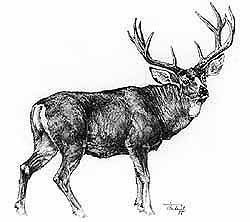English: Mule Deer; French: Cerf Mulet; Chipe-wyan: yatué; Cree: apseemoosis; Dogrip: tohdzi; Spanish: Ciervo mula.
 |
Former distribution: As now.
Present distribution: Coastal regions and islands of Alaska, south to Yukon Territory, British Columbia, Alberta, Saskatchewan, North Dakota, South Dakota, Nebraska, Kansas, Minnesota, Iowa, Missouri, Texas, Oklahoma, Colorado, New Mexico, Arizona, Nevada, California, Oregon and Washington, Mexico. Introduced into the Hawaian Islands.
Behaviour: Preferred habitat: from semi-desert regions in the south to tall grassy prairies, shrublands, woodlands, forests in the Rocky Mountains, and north subarctic land. They do not usually form herds, 2-4 together is normal. They feed and browse on plants, grass and leaves and are active diurnally and at twilight. Predators include wolves, lynxes, bears, pumas.
Population status: Stable. Estimated numbers: 4-5 million.
Brief notes:
Body weight: 100-130 kg (-180?)
Head and body length: 150-280 cm
Tail length: 15-30 cm
Shoulder height: 100-110 cm
Gestation period: 203 days
Maximum age: Up to 20 years
Trophy: Record SCI: Typical antler 180 7/8 score, 1982 USA, Colorado, RIC MARTIN; average 130 score. Non-typical antler 276 7/8 score, 1968 USA, Wyoming, BUCK HEIDE; average 160 score. Columbia Mule Deer (O.h. columbianus) 147 3/8 score, 1976 USA, Washington, MAURICE HELDRITH; average 80 score. B&C: Typical antler 225 6/8 score, 1974 USA, Colorado, DOUGH BURRIS jun.; typical antlers average 195 score. Non-typical antler 355 2/6 score, 1926 Canada, Alberta, ED BRODER; average 240 score. Columbia Mule Deer (O.h. columbianus) 170 6/8 score, USA, Oregon, CLARK D. GRIFFITH; average 130 score.
Hunting methods: Stalking, on horseback.
Subspecies: 8
1. Odocoileus h. hemionus Rocky Mountains from Yukon south to Texas and New Mexico; east to central USA and Canada. Stable.
2. Odocoileus h. crooki South-western Arizona, New Mexico, Texas; northern Mexico. Stable.
3. Odocoileus h. californicus Central California. Stable.
4. Odocoileus h. fuliginatus San Diego region in California, and lower California. Stable.
5. Odocoileus h. peninsulae Southern region of lower California. Stable.
6. Odocoileus h. cerrogensis Cedvo Islands. Stable.
7. Odocoileus h. columbianus Coastal region from central California north to Port Simpson. Stable.
8. Odocoileus h. sitkensis Coastal southern Alaska south to Port Simpson. Stable.
Remarks: It was estimated that about 10 million Mule Deer were in existence when the white man arrived; the population decreased to 500 000 in 1908 (SETON 1937). For the future it can be expected that the Mule Deer population will remain stable, provided habitat destruction can be controlled and the biotope well managed. WEMMER (1982) divides the Odocoileus hemionus into 2 groups: Odocoileus h. hemionus (Mule Deer), and Odocoileus h. columbianus (Black-tail Deer). More investigations on their status are required.







